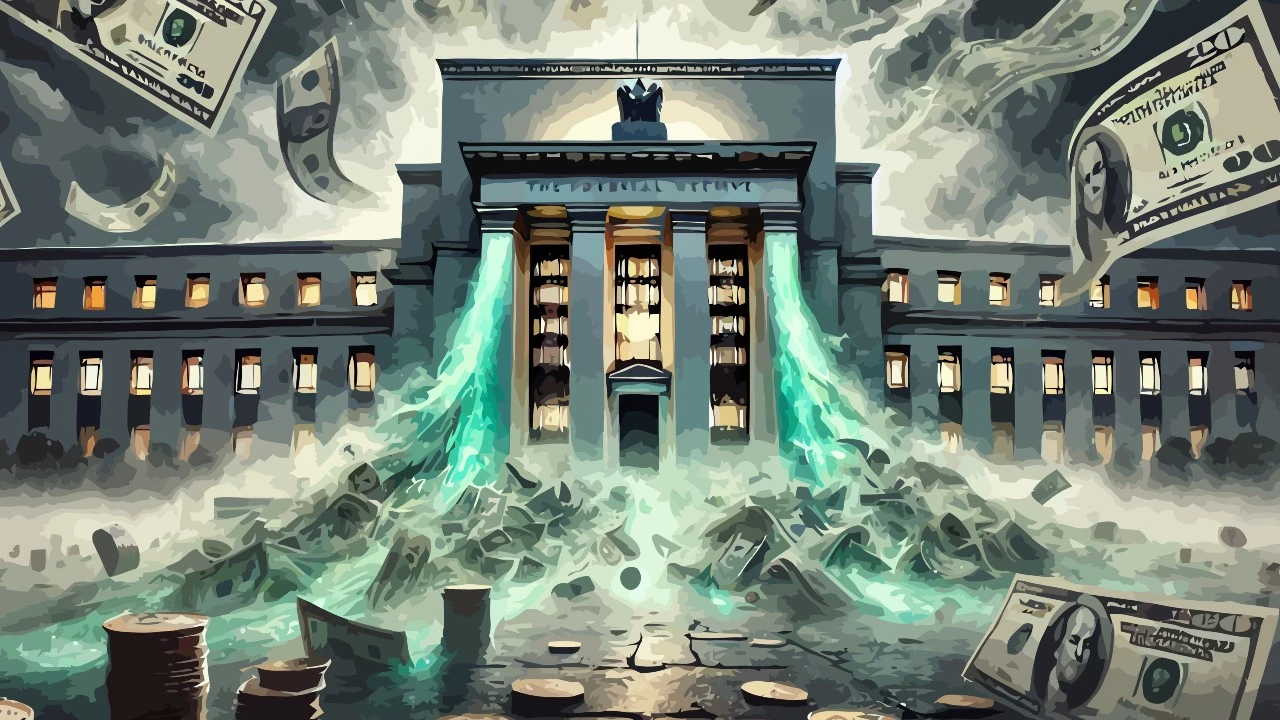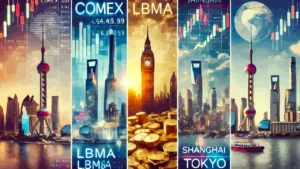Money is at the heart of our daily lives, but few people really understand how the modern banking system works and the hidden mechanisms behind the creation of money. The banking system does more than just store our savings or grant loans: it is an integral part of a complex economic mechanism in which different institutions, such as central banks and commercial banks, interact to keep money flowing in the economy.
In this article, we will explore the main players in the modern banking system, analyze how money is created, and see what dynamics govern global economic stability.
Contents
#1. Basics of modern banking
The modern banking system is the beating heart of the global economy. Its main function is to facilitate the flow of money between individuals, businesses, and governments. This system is based on a fundamental principle: trust. People deposit their money in banks with the certainty that it can be withdrawn at any time, but the reality is more complex.
Banks do not simply store deposits but use them to generate new loans and investments. This continuous cycle of money in and out fuels the real economy and affects GDP growth, employment and inflation.
The banking system is based on three main pillars:
- Financial intermediation: banks collect savings and transform them into credit for families and businesses,
- Risk management: Through financial instruments, banks redistribute economic risks,
- Liquidity Creation: Banks increase the availability of money in the economy through lending and investment.
The flow of money between banks, citizens and businesses is regulated by strict regulations and central bank supervision, which intervenes to maintain economic stability.
The modern system is not limited to cash and bank deposits: today, much of the money exists only in electronic form, in the form of credits in bank accounts. This has enormous implications for the management of money and the vulnerability of financial markets.
Furthermore, technological innovation has profoundly transformed the banking sector. The introduction of electronic payments, home banking platforms (I can’t find an Italian term with the same effectiveness) and cryptocurrencies have revolutionized the way money is managed and transferred. However, these innovations have also increased the complexity of the system and introduced new risks related to cybersecurity and data security.
The modern banking system also faces challenges related to sustainability and social responsibility. Banks are increasingly called upon to finance projects that comply with environmental, social and governance (ESG) criteria, thus contributing to more equitable and sustainable economic development.
Globalization has made the banking system even more interconnected. Financial crises that affect one country can quickly spread globally, as the 2008 crisis demonstrated. This phenomenon has highlighted the importance of international regulation and mechanisms for cooperation between central banks .
Finally, it is essential to understand that the banking system is not a static entity, but a dynamic organism that is constantly evolving. Economic policies, technological innovations, and changes in consumer behavior constantly influence the functioning of banks and the management of money.tori influenzano costantemente il funzionamento delle banche e la gestione del denaro.
#2. Main players
The modern banking system involves three main actors. Central banks regulate the money supply, set interest rates, and ensure financial stability. Commercial banks provide services such as loans, deposits, and checking accounts to households and businesses. Finally, non-financial institutions like pension funds, insurance companies, and fintech firms play a growing role in credit intermediation and wealth management.
Central bank
The central bank is the backbone of the banking system. In each country (or group of countries, such as the ECB for the Eurozone), it controls monetary policy and has a monopoly on issuing legal tender. Its main task, or at least what it should be, is to maintain price stability, control inflation and ensure the stability of the financial system.
The main tools used are:
- Interest rates that determine the cost of money for commercial banks:
- Deposit rate: This is what the central bank pays commercial banks to leave their funds on deposit with it, usually overnight.
- Main refinancing rate: it is applied to the weekly operations with which the central bank lends to banks and is the main instrument of monetary policy,
- Marginal lending rate: This is the rate at which banks can obtain liquidity from the central bank within a single day, but on less favourable terms,
- Open market operations: purchase or sale of government bonds to regulate liquidity,
- Required reserve: The percentage of money that commercial banks must keep on deposit with the central bank.
In addition to these tools, the central bank acts as a lender of last resort, providing liquidity to troubled banks to avoid systemic crises.
Central bank policies directly influence the real economy. Lowering interest rates stimulates consumption and investment, while raising them helps contain inflation. The bank can also intervene through quantitative easing or tightening. However, every action carries long-term risks and consequences.
Commercial banks
Commercial banks are the direct interface with citizens and businesses. In addition to managing current accounts, they offer loans, mortgages and other financial services. Through the fractional reserve system (which we will see later), they have the power to create virtual money, multiplying customer deposits.
Commercial banks play a crucial role in the real economy, providing credit to households and businesses and indirectly influencing economic growth. However, their activity also entails significant risks, such as exposure to non-performing loans or liquidity crises.
In recent years, commercial banks have expanded the range of services they offer to include financial advice, wealth management, and mutual fund investments. The goal is to diversify sources of income and reduce dependence on bank loans alone.
Digitalization has also transformed the relationship between banks and customers. Online platforms and mobile apps allow you to manage accounts and investments in real time, increasing the accessibility of financial services. However, this evolution has made banks more vulnerable to cyber attacks, imposing new security challenges.
Non-banking financial institutions
Foundations, insurance companies, pension funds, and investment firms play a crucial role in financial markets, although they do not have the power to create money. However, their influence on capital flows can affect overall economic stability. These institutions manage huge volumes of capital and often invest in government bonds, corporate bonds, and stock markets, influencing the dynamics of the banking system.
Non-bank financial institutions also play a key role in providing protection against financial risks. Insurance companies, for example, provide coverage against unexpected events, while pension funds provide long-term financial security.
In addition, investment funds and private equity firms (which invest in private companies to resell them at a profit) play an active role in financing businesses, contributing to economic growth and innovation. However, their activity can also increase the volatility of financial markets and create economic imbalances.
Non-bank financial institutions are therefore key players in the modern economy, capable of influencing global dynamics while operating outside the traditional banking system.
#3. From LIBOR to SOFR
LIBOR and SOFR are benchmark rates used to calculate interest on loans, mortgages and derivatives. They serve as the basis for determining the cost of money in financial markets.
LIBOR was born in response to a need for international financial coordination but lost legitimacy due to its opaque and manipulable structure. SOFR, on the other hand, was developed as a modern and more reliable solution, rooted in real transactions and designed to ensure stability and trust in contemporary markets.
LIBOR (London Interbank Offered Rate)
LIBOR (London Interbank Offered Rate) was officially introduced in 1986 by the British Bankers’ Association to meet a growing need in global financial markets: to have a common benchmark rate to settle loans and derivatives. With the expansion of international finance and the spread of products such as variable rate mortgages and OTC derivatives, a uniform indicator was needed to reflect the cost of money among the world’s major banks.
LIBOR was calculated daily based on estimates by a panel of large banks indicating at what rate they would be willing to lend unsecured funds to other banks. This structure made it extremely influential: it was adopted as a benchmark for contracts worth trillions of dollars, becoming a central element of the global financial architecture.
However, its non-transactional nature made it vulnerable to manipulation. This problem emerged dramatically with the 2012 scandal, when it was shown that several banks had deliberately distorted their estimates to gain financial advantage or to appear more solid. This undermined confidence in the system and triggered a process of global review of reference rates.
SOFR (Secured Overnight Financing Rate)
In response to the problems of LIBOR, financial authorities began to design alternative rates based on actual transactions and not on subjective declarations. In the United States, this need led to the birth of the SOFR (Secured Overnight Financing Rate), introduced in 2018 by the Federal Reserve and the Office of Financial Research. SOFR represents the weighted average rate of overnight secured financing operations, in which US Treasury securities are used as collateral in the REPO (repurchase agreement) market.
Unlike LIBOR, SOFR is based on a huge volume of real daily transactions, which makes it more transparent, robust and less susceptible to manipulation. However, it is a risk-free rate, as it reflects secured lending, and this implies significant differences in its dynamics compared to LIBOR, which implicitly included a credit risk premium.
For this reason, the transition from LIBOR to SOFR required the introduction of adjustment spreads and contractual changes to ensure economic continuity in pre-existing contracts. SOFR has gradually established itself as the new standard in US markets, as part of a broader global reform of benchmarks, which has also involved other jurisdictions with alternative rates such as the €STR in Europe and SONIA in the United Kingdom.
LIBOR and SOFR to individuals and businesses
Even though they are interbank rates, they are used for individuals and businesses because they represent a standardized and recognized base to which banks anchor lending interest rates. Rates such as LIBOR (now being discontinued) or SOFR reflect the cost of money between financial institutions, but are used as benchmarks in mortgage contracts, corporate loans and derivative products.
Banks apply a spread (differential) above these rates to take into account the specific risk of the customer and operating costs. Consequently, if LIBOR or SOFR increases, mortgage payments or the cost of credit for businesses also increase. This link makes interbank rates a key tool in the transmission of monetary policy to the real economy. The value of bonds and complex financial instruments is also often tied to these rates, making them central to financial management.
#4. Fractional reserve banking
The fractional reserve system allows commerical banks to lend out a portion of deposits while keeping only a fraction as a required reserve. This mechanism increases liquidity in the economic system, but also introduces significant risks, such as the phenomenon of bank runs, in which customers try to withdraw their funds at the same time, putting the bank in crisis.
The percentage of the required reserve is set by the central bank and is used as a lever to control inflation and the amount of money in circulation.
A customer deposits €1,000. The bank, thanks to the fractional reserve system, can lend 90% of that deposit (€900) to another customer. The latter, in turn, will deposit the €900 in another bank that can lend 90% (€810) and so on. This mechanism multiplies the money in circulation without it ever having been physically printed.
The advantage of this system is its ability to expand the money supply without the need to physically print new money. However, it also carries the risk of creating an excessive amount of debt relative to the funds actually available.
Trust is the key to the fractional reserve system. If depositors lose confidence in the soundness of banks and simultaneously try to withdraw their funds, the system risks collapsing. For this reason, central banks play a key role in ensuring financial stability and intervening in the event of a crisis.
Regulation is essential to prevent and manage the risks associated with fractional reserve banking. Supervisors impose capital requirements on banks, monitor the quality of loans granted, and set limits on leverage.
During economic crises, central banks can adjust reserve requirements to stimulate or slow monetary expansion. For example, reducing reserve requirements during a recession increases banks’ ability to lend, which helps the economy recover.
The fractional reserve system is therefore a powerful but delicate tool, which requires a constant balance between economic growth and financial stability.
#5. Inflation and interest rates
Excessive money creation can lead to inflation, which is a general increase in prices. The central bank uses interest rates as its main tool to regulate the economy:
- Raising rates: reduces the money in circulation, curbing inflation,
- Lower interest rates: Encourages lending and investment, spurring economic growth.
Managing interest rates is a delicate balancing act. Too low a rate can lead to asset bubbles and inflation, while too high a rate can slow economic growth and increase unemployment.
In addition to interest rates, central banks use open market operations and quantitative easing policies (buying securities to increase liquidity) to influence the economy.
👉 Read also: QE vs QT: Easing and Quantitative Tightening
Controlling inflation is, or at least should be, one of the main objectives of central banks. Moderate inflation stimulates economic growth, while too high inflation reduces purchasing power and destabilizes markets.
Finally, a country’s exchange rate and trade balance can be influenced by monetary policy. Higher interest rates attract foreign investment, strengthening the domestic currency, while lower rates can boost exports but weaken the currency.
Managing inflation and monetary policy is therefore one of the most powerful tools that central banks have at their disposal to maintain macroeconomic stability.
However, controlling inflation is not without its problems. External factors, such as energy crises or geopolitical tensions, can influence prices independently of monetary policy. In these cases, central banks must balance the need to contain inflation with the need to support economic growth.
Consumer and business expectations play a crucial role in the course of inflation. If people expect prices to rise, they will tend to spend more in the present, further fueling inflation. For this reason, central banks seek to influence expectations through transparent communication of their strategies.
Finally, monetary policies do not operate in isolation. They must be coordinated with governments’ fiscal policies to ensure effective management of the economy. In times of crisis, such as during the COVID-19 “pandemic,” cooperation between central banks and governments has been crucial to stabilizing markets and supporting economic recovery.











Leave a Reply